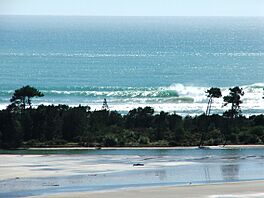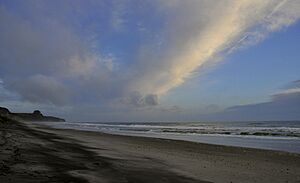Bay of Plenty facts for kids
Quick facts for kids Bay of Plenty |
|
|---|---|

The Bay of Plenty seen from Whakatāne. The Whakatāne River (foreground) is one of eight major rivers that empty into the bay.
|
|
| Coordinates | 37°40′S 177°00′E / 37.667°S 177.000°E |
| Native name | Te Moana-a-Toitehuatahi (Māori) |
| Etymology | Named by James Cook for an abundance of resources; Māori name in honour of Toi-te-huatahi |
| River sources | Raukokore River, Kereu River, Haparapara River, Motu River, Hawai River, Waioeka River, Waiotahe River, Whakatāne River, Rangitaiki River, Tarawera River, Kaituna River, Wairoa River, Wainui River, Aongatete River, Otahu River, Wentworth River, Wharekawa River |
| Ocean/sea sources | Pacific Ocean |
| Basin countries | New Zealand |
| Islands | Mayor Island / Tūhua, Mōtītī Island, Motunau / Plate Island, Moutohora Island, Te Paepae o Aotea, Whakaari / White Island |
| Sections/sub-basins | Whangamatā Harbour, Tauranga Harbour, Ōhiwa Harbour |
| Settlements | Whangamatā, Waihi Beach, Tauranga, Whakatāne, Ōpōtiki |
The Bay of Plenty, known in the Māori language as Māori: Te Moana-a-Toitehuatahi, is a large, curved bay on the northern coast of New Zealand's North Island. It stretches for about 260 kilometres from the Coromandel Peninsula in the west to Cape Runaway in the east.
The Māori name means "the Ocean of Toitehuatahi," honouring an early ancestor named Toi-te-huatahi. The English name was given by Captain James Cook in 1769. He was impressed by the large, well-stocked Māori villages he saw, which had plenty of food. This was very different from another place he had visited, which he named Poverty Bay.
Contents
Geography and Nature
The Bay of Plenty has a long coastline of about 259 kilometres. People use the coast for fishing, business, fun activities, and cultural reasons. The western part of the coast has sandy beaches, while the eastern part is more rocky.
Important harbours can be found in Tauranga, Whakatāne, and Ohiwa. Many large rivers flow from the land into the bay, including the Wairoa, Kaituna, and Rangitaiki rivers.
Whakaari / White Island: An Active Volcano

One of the most famous features of the bay is Whakaari / White Island, an active volcano. It is New Zealand's most active cone volcano and has been forming for over 150,000 years. The island we see is just the top of a much larger volcano that sits on the ocean floor. It rises 321 metres above the sea.
Whakaari has a long history of volcanic activity. It has been releasing volcanic gas almost constantly since Captain Cook first saw it in 1769. In the past, people mined sulphur on the island. Sadly, in 1914, a landslide in the volcano's crater killed ten miners.
The volcano has erupted many times. A sudden eruption in December 2019 happened when tourists were visiting. This was a tragic event that resulted in 22 deaths and many injuries.
Climate
The Bay of Plenty has a temperate, maritime climate. This means it has warm, humid summers and mild winters.
History of the Bay
Early Māori History
According to Māori traditions, the Bay of Plenty was where many of the first Māori settlers arrived in New Zealand. They travelled across the ocean in large canoes called waka. Some of these famous waka were the Mātaatua, Arawa, and Tainui.
The descendants of these first settlers formed tribes, or iwi, that still live in the region today. These iwi include Te Whānau-ā-Apanui, Ngāti Awa, and Ngāi Te Rangi. The bay was named Te Moana-a-Toi (The Ocean of Toi) after an important ancestor.
European Arrival and Settlement
The first European to visit was Captain James Cook in 1769. After him, more Europeans, like missionaries and traders, began to arrive in the early 1800s. For a time, whaling stations were also set up in the bay to hunt whales.
In the 1820s and 1830s, a period of fighting known as the Musket Wars took place. Northern iwi, who had new weapons like muskets, travelled to the Bay of Plenty and fought with the local tribes.
The New Zealand Wars
More conflict came to the region in the 1860s during the New Zealand Wars. These were a series of battles between some Māori iwi and the British government over land and authority. In the Bay of Plenty, iwi from Tauranga supported other tribes who were fighting the government.
As a result, British forces attacked the Tauranga iwi. One of the most well-known battles was the Battle of Gate Pā in 1864. After more conflicts, the government took large areas of land from the local Māori iwi. This was known as land confiscation and it had a major impact on the tribes, who lost their homes and resources.
Growth and Industry
After the wars, the government set up towns like Tauranga and Whakatāne. European settlers began to arrive and start farms. At first, it was difficult to farm because of the climate and lack of good roads.
However, by the early 1900s, settlers discovered that the land was perfect for dairy farming. Factories were built to make butter and cheese, which helped the region's economy grow. Later, in the 1950s, the timber industry became important, and after that, the Bay of Plenty became famous for growing kiwifruit.
Important Modern Events
The MV Rena Oil Spill
On October 5, 2011, a large cargo ship called the MV Rena hit the Astrolabe Reef in the bay. The ship broke apart and spilled a huge amount of oil into the ocean.
This oil spill was a major environmental disaster for New Zealand. The oil harmed birds and sea life, and many people worked hard to clean up the beaches and help the affected animals.
2019 Whakaari / White Island Eruption
As mentioned earlier, a deadly volcanic eruption happened on Whakaari / White Island on December 9, 2019. This event reminded everyone of the power of nature and the dangers of active volcanoes.
See also
- List of schools in the Bay of Plenty Region



